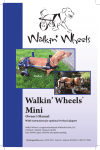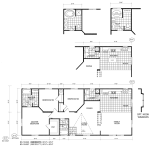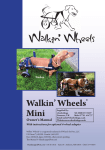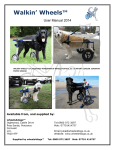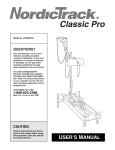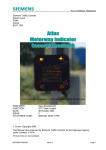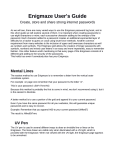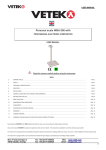Download Walkin` Wheels® Medium Owner`s Manual
Transcript
Walkin’ Wheels® Medium Owner’s Manual With instructions for optional Fully Supportive Front Wheel Kit Walkin’ Wheels® is a registered trademark of Wheels for Pets, LLC US Patent 7,549,398. Canada 2,641,092 Euro 2050418, Japan 5385584, other patents pending. HandicappedPets.com • 105 Rt 101A – Suite 18 • Amherst, NH 03031 • (603) 577-8854 Thank you for purchasing Walkin’ Wheels® Medium dog wheelchair. Questions or comments? Call us (603) 577-8854 or email us at: [email protected]. Contents Parts of the Walkin’ Wheels Medium Wheelchair..............................................................................3 Tips to Teach Your Dog to Use Walkin’ Wheels® ...............................................................................4 Setting Up the Dog Wheelchair..............................................................................................................6 Use Snap Buttons to Adjust Length, Width and Height....................................................................7 Adjusting the Length.................................................................................................................................9 Is the Length Correct?..............................................................................................................................9 Adjusting the Width............................................................................................................................... 10 Attaching the Struts and Wheels......................................................................................................... 11 Adjusting the Height.............................................................................................................................. 11 Stirrups...................................................................................................................................................... 11 Clip the Leg Rings to the Wheelchair................................................................................................. 12 Front Harness Attachment.................................................................................................................... 13 Is the Wheelchair Adjusted Properly? ............................................................................................... 14 Optional Set Screws for Noise Reduction......................................................................................... 15 Belly Belt, if Needed .............................................................................................................................. 15 Wheel Options ....................................................................................................................................... 16 Foam Wheels 4”, 8”, 12” and 16” ....................................................................................................... 16 Air Tires Only Available in 12” and 16” ............................................................................................. 17 Walkin’ Wheels® Front Leg Attachment ............................................................................................ 17 In the Package.......................................................................................................................................... 18 Assembling the Fully Supportive Wheelchair.................................................................................. 19 Putting the Dog Into the Fully Supportive Wheelchair.................................................................. 22 Wear, Maintenance, Liability and Guarantee ................................................................................... 23 Limited Liability ..................................................................................................................................... 23 Optional Items and Accessories........................................................................................................... 24 2 Walkin’ Wheels® Medium User Manual ©2015 Parts of the Walkin’ Wheels Medium Wheelchair The Wheels, attached to snap-in struts, are either packaged inside the box with the frame, or packed separately. 15” 6” 9” 26” Length Extenders. The 15” extenders are installed in the frame. The 26” extenders are used for longer dogs Aluminum wheelchair frame Width Connector and Extenders installed Width Connectors. The 6” connector is already installed in the frame. Extra 9” connector for wider dogs. Knuckle (attached to frame). Tool kit with Allen wrench and cup screws for noise reduction (use if desired). Leg Rings for rear support. Stirrups to keep the feet from dragging, (use if needed). Front Harness with comfort sleeves. Small Large One Belly Belt for mid-section support (use if needed), small or large. Walkin’ Wheels® Medium User Manual ©2015 3 Wheels attached to Struts (one set for each wheelchair) Several sizes shown here. Instructional video and just-for-fun movies. Tote Bag and Handles to allow you to use leg rings as a lifting harness. Tips to Teach Your Dog to Use Walkin’ Wheels® We created the Walkin’ Wheels ® with the intention that you will adjust the wheelchair, put your pet in it, and in a few moments watch him or her running and playing again. It can happen that way, but it doesn’t always. A wheelchair can be an adjustment for an animal. To some, there is a strange device following him or her around making odd noises and getting caught on furniture and doorways. They will adapt to these changes, but need a little time. We recommend you be calm, quiet, and slow when putting on the wheelchair for the first time. Lots of stroking and reassurance is needed here. Treats help, too! Let the dog get used to the harness before attaching it to the wheelchair. It may take a few minutes or a few hours for him or her to get used to the harnesses. 4 Walkin’ Wheels® Medium User Manual ©2015 1.When starting this process we suggest that you use the dog’s favorite treats to reward your dog for walking forward. You won’t need to keep using these treats every day, just in the beginning of the training process. A hungry dog is a motivated dog! Work with your dog before you have fed him a meal. He will be more eager to pay attention and earn the food reward if he is hungry. 2.Do not immediately put your dog in the wheelchair. Assemble the wheelchair and leave it in an area where your dog can see it, smell it and touch it. 3.Once the dog is comfortable near the wheelchair, put the front harness on and heave him or her alone for a while. Let the dog get used to the feeling of the straps. 4.When your dog is comfortable, try putting him in the leg ring support system and attach the front harness to the wheelchair. Give him a treat for positive association. 5.After your dog is in the wheelchair hold the food reward right at his nose level. Feed him several pieces. Then you can move one foot backwards, again holding the food reward in front of you. He should then walk toward you to get the treat. Before you know it, he is walking in his Walkin’ Wheels! Again, give him a treat and positive praise. 6.Work in very short (5-10) minute sessions, several times a day. Give your dog rest periods between each session. Note: Keep in control of the dog’s movement at first. Keep the dog in a clear area and keep him on a short leash. If the dog does become frightened, then disconnect the harness from the wheelchair and try again later. Until your dog gets used to the Walkin’ Wheels, limit the amount of time spent in it. The Walkin’ Wheels is designed to allow your dog to get exercise and physical therapy. Dogs cannot lie down in the wheelchair but will be able to urinate and defecate while in the wheelchair. Start with short periods and increase slowly. Make sure you don’t overdo it the first day. Walkin’ Wheels® Medium User Manual ©2015 5 Setting Up the Dog Wheelchair Adjusting the Knuckle The frame is shipped flat. Set the legs perpendicular to the frame by turning the dial caps counter-clockwise to loosen the knuckle assembly. Don’t remove the dial caps. Move the leg to the correct position using the raised indicators as your guide. The inside indicator should be in the center of the two outside indicators as shown in the photo below. Once the leg is in the correct position, tighten the dial cap by turning clockwise. Right Correct Straight Leg Position Wrong If you only see two raised indicator marks, then the wheelchair is upside down. Flip the leg 180 degrees. For active dogs, you can angle the wheels back a notch. Right Wrong 6 Don’t angle the wheels too far back as it will put too much pressure on their shoulders. Walkin’ Wheels® Medium User Manual ©2015 Angle of the legs Normally, the wheels are set straight up and down as shown on the brown dog. Setting the wheels back slightly, like the white dog, will offer a bit more stability for stronger, more active dogs, or dogs who are shifting their weight back toward their hindquarters. Use Snap Buttons to Adjust Length, Width and Height. The Snap buttons are an easy way to adjust the length, width, and height of the Walkin’ Wheels dog wheelchair. Use a pen to push the Snap Button when it is inside the knuckle. Walkin’ Wheels® Medium User Manual ©2015 7 Replacing the Length Extenders and width connectors. The Walkin’ Wheels comes with two sizes of width connectors and length extenders. For larger or smaller dogs you may need to switch them. To remove an extender or connector, depress the snap button until extender or connector slides out of the wheelchair tube. Use the guidelines below to choose the right one. 1) Short (6 inch) Width Connector snaps into the back of the wheelchair for dogs less than 9 ½” wide (measured at the widest point of the dog). This is already installed in the frame. 2) Short (15 inch) Length Extenders snap in to the sides of the wheelchair for dogs less than 19” in length (measured from the back of the front leg to back of the rear leg). These come installed in the frame. 3) Long (9 inch) Width Connector snaps into the back of the wheelchair for dogs greater than 9 ½ inches wide (measured at the widest point of the dog). This is included in the box. 4) Long (26 inch) Length Extenders snap into the sides of the wheelchair for dogs greater than 18” long (measured from the back of the front leg to back of the rear leg). These are included in the box. 8 Walkin’ Wheels® Medium User Manual ©2015 Adjusting the Length The extenders are for length adjustments. The kit comes with two sets, one set is 15” and the other set is 26” long. Start by using the set that is already installed in your wheelchair. Is the Length Correct? The end of the extenders (black cap) should be positioned at the center of the dog’s shoulder blades. The extenders should be touching the neoprene pads on the front harness and not pulling outward. If the sides tilt up, then loosen the blue strap on the front harness over the dog’s back and tighten up the red bottom strap. If the extenders tilt down, loosen the red bottom strap and tighten the blue strap over the dog’s back. INCORRECT INCORRECT Walkin’ Wheels® Medium User Manual ©2015 9 The side extenders should be parallel to the ground and in the middle of the dog’s body. CORRECT Adjusting the Width Use the snap buttons on the width connector to adjust the wheelchair to the proper width. There should be at least ½” on each side of the hips. The width adjustment will be determined by the widest part of the dog which is usually the chest. The width connector that is attached to the frame is 6” long and will extend to 9.5”. If you need additional width, we have also included a 9” connector that adjusts to 13”. 10 Walkin’ Wheels® Medium User Manual ©2015 Attaching the Struts and Wheels You received your wheelchair with the correct size strut and wheel combination according to your dog’s fold of flank measurement. Insert the strut into the wheelchair leg and adjust to the height needed. If you need a different size wheel and strut, contact us. Adjusting the Height The correct height setting is based on both the height and the condition of the dog. If the dog has some use of his/ her back legs, then use the snap buttons to adjust the height so the dog’s toe pads are on the ground and the dog can participate in the walking motion. If the back legs are very weak then the paws can scrape on the ground or knuckle under. In this case put the legs in the stirrups or protect them with Walkin’ Pet Boots. Stirrups Stirrups are optional for paws that are dragging or knuckling under. The stirrups attach to the back of the wheelchair on each silver metal loop (also called “eye pads”). The rubber tubes on the stirrups need to be above the dog’s hock. Use the push lock to adjust to a snug fit. The dog’s leg should be several inches off the ground. You can adjust the length of the cord by retying the knot. If you use the stirrups, use both. Using only one stirrup causes the dog to feel unbalanced. IMPORTANT: When taking the dog out of the wheelchair, make sure to release the stirrups FIRST. Rear Support Leg Rings The Leg Rings support the dog’s hindquarters. They will take the weight off your pet’s legs while still allowing him or her to use their legs to maintain muscle mass. The leg rings need to be tight to create a firm ‘seat’ or saddle for the dog in order to support the dog properly. The leg rings should hang no lower than 1” below the frame. Walkin’ Wheels® Medium User Manual ©2015 11 When the dog is in the leg rings, the wheelchair knuckle should be at mid-hip level. The leg rings should look like two C’s and not two V’s with the center connector holding them together. Clip the Leg Rings to the Wheelchair The leg ring straps go over the frame and the black plastic harness clips have a slot that fits over the shoulder socket screws. Put your thumb into the round circle and push upward to lock (you will hear it click into place). The round circle will face the ground. The dog’s legs go through each ring. To release, put your thumb in the circle and pull downward. Now, you can slowly lower your dog to the ground. The excess Velcro strapping will cross over the dogs back or use the excess strapping to form handles. The Velcro center connector can be moved forward or backward to avoid putting pressure on the dog’s genitals (ideal for intact dogs). In addition, the Velcro connector can be wrapped loosely so there is space between the rings. The Velcro center connector MUST be used. Adjust for best comfort and fit. 12 Walkin’ Wheels® Medium User Manual ©2015 The rubber tubing can be cut shorter if needed (do not cut the strapping). Try cutting about an inch off all four ends of the rubber then adjusting the tri-glides on the straps to tighten them up. Front Harness Attachment Adjust the extenders so they reach the harness clips on the front harness. The extenders will go through the D-rings and then clip into the front harness. The D-rings should be positioned just behind the shoulder blades. Adjusting the Front Harness: • Take the 3 comfort sleeves off the harness so you can make sizing adjustments. • The dog’s head goes between the black strap and the blue strap. • Blue strap goes over the dogs shoulder. • Red strap goes behind the front legs and clips into the side of harness. • Black strap goes under neck across front of chest. • Male prong clips point to the back. • All three straps should be snug. Comfort sleeves can be cut for smaller dogs and excess straps tucked in. This material will not fray. Walkin’ Wheels® Medium User Manual ©2015 13 Is the Wheelchair Adjusted Properly? When the wheelchair is adjusted properly, the dog stands in a natural position. Here is what to check: A Knuckles should be in line with the hips. B Front harness D-Ring clips clip into extenders behind shoulder blade. Back should be straight. C Extenders parallel to the ground and do not extend past the front legs. D/E Toe pads touching the ground or put into stirrups. If you are unsure whether the wheelchair is fitted properly, please email rear view and side view photograph of your dog in the wheelchair to: messages@ handicappedpets.com and we will evaluate the fitting. Make sure you include the name the wheelchair was ordered under and your phone number. 14 Walkin’ Wheels® Medium User Manual ©2015 Optional Set Screws for Noise Reduction Using the set screws will tighten up your wheelchair and reduce any rattling noises. The set screws also keep the wheelchair tight after it has been adjusted for your dog. When you tighten up the wheelchair, the side arms called extenders will be able to move up and down as your pet turns corners. This is completely normal. The flexibility also allows for ease of movement on uneven terrain. There are six places to put the set screws using the Allen Key. Do not overtighten. They are indicated below showing arrows. Note: Make sure the set-screws shown below are loosened or removed before adjusting. Belly Belt, if Needed Some animals will need additional support under their belly. You can tell the dog needs additional support if their spine bows downward. It is also helpful for overweight dogs or dogs with spinal or disc issues. One end of the belly belt has a tri-glide (rectangular with bar in the middle) attached and the other side has Velcro strapping. Both sides have a rope with a push button adjuster. Figure A Figure B Walkin’ Wheels® Medium User Manual ©2015 Figure C 15 A. Take the side with the tri-glide and put the extender through the end loop. B. Take the rope and put over the harness clip on the extender. After you attach the front harness to the harness clip, the rope will be secured. This will keep the belly belt from sliding backwards. Now, adjust the belly belt so it is in the middle of the dog’s belly. C. Secure the other side over the extender and Velcro to bottom of belly belt. The purpose of the belly belt is to provide support for your dog’s mid-section Wheel Options We offer four size wheels, 4”, 8”, 12”& 16” Air Filled vs Foam Filled Air-Filled Foam Foam Wheels 4”, 8”, 12” and 16” • Lightweight, high density foam material that offers a smooth ride • These wheels wear extremely well and will never go flat • They are made for all terrain • 4” & 8” wheels have ¼” hub, 12” & 16” have ½” hub with bearings • True closed cell technology/ no water absorption • Easy to clean 16 Walkin’ Wheels® Medium User Manual ©2015 Air Tires Only Available in 12” and 16” • Active dogs that do off-road hiking • Offer more shock absorbency • Similar to mountain bike tire with deep treads • Will need to replace tubes or wheels if punctured • Require 30 PSI air • 12” & 16” wheels have ½” hub with bearings • Additional cost If you switch from an 8” wheel to a 12” wheel, you will need to purchase the appropriate struts and hardware. Call us if you have any questions. Saltwater, mud and sand can cause rust or erosion to the hardware and bearings. We suggest hosing the wheels down after exposure to prolong the life of your wheelchair. Walkin’ Wheels® Front Leg Attachment The Walkin’ Wheels® Front Wheel attachment gives mobility to dogs with front leg weakness or weakness in all four legs. It is ideal for helping disabled pets get exercise and for rehabilitation while they are healing. Like the rest of the Walkin’ Wheels® products, the front wheel attachment is adjustable so it will fit the Walkin’ Wheels wheelchair for any size dog from 20 to 150 pounds and can be easily removed at any time. This attachment will not work with the Walkin’ Wheels Mini Dog Wheelchair. Walkin’ Wheels® Medium User Manual ©2015 17 In the Package The front wheel kit attachments are easy to assemble and snap into the wheelchair. You will need a Phillips Head Screwdriver. The package contains: A – Left and Right Extenders (2) B – Struts and Casters (2) C –Legs (2) D –Chin Bar & Extension pieces (3) E – Allen Key/Wrench (2) F – Front Bar Screws (2) G – Chin Bar Comfort Cover (1) H – Front Leg Rings (1 Pair) IMPORTANT: The LEFT and RIGHT Struts and Casters (B) must match the LEFT and RIGHT Legs (C). If they are not installed correctly the wheelchair will be extremely wobbly. We refer to L and R as if you are in the wheelchair. 18 Walkin’ Wheels® Medium User Manual ©2015 Assembling the Fully Supportive Wheelchair Video instructions also available: http://hpets.net/qa.htm Step 1. Attaching the legs (C) to the extenders (A) The top of each leg is labeled with an L or an R. It is crucial that the legs are installed on the correct side. The extenders are not labeled L or R but the shoulder socket screws face the outside. Attach the leg to the extender with (2) screws using the larger Allen key. The legs will be at a forward angle. Step 2. Side Extenders Remove the existing side extenders from your rear Walkin’ Wheels and snap in the left and right front extenders (A). Step 3. Insert the Strut and Caster Assembly (B) into the Leg (C) These are marked with “L” and “R”. It is very important that they are installed on the correct sides. Important! Notice the ledge on the Caster Connector. This needs to be facing outward in order for the front wheel attachment to work properly. Step 4. Adjust the Chin Bar (D). Note: Use of the Chin Bar is optional. The Chin Bar adds stability and rigidity to the front wheel attachment. It needs to approximately match the width of the back of the Walkin’ Wheels. Use a Philips head screwdriver to remove the two screws on the Chin Bar and adjust it so that the width of the Chin Bar is approximately the same as the width of the back of the wheelchair. Insert screws to secure in place. 20 Walkin’ Wheels® Medium User Manual ©2015 The chin bar attachment only has threads on one side of the bar. You will notice that the bar with the large holes has no thread. That is the side the screw needs to feed through. Attach the extension piece to the outside of the chin bar using the included screws and washers. Insert the Chin Bar into the openings at the front of the Left and Right Extenders using the thumbscrews. The Chin Bar is held on by the two Chin Bar Screws (F). Put the Chin Bar Comfort Cover (G) on the Chin Bar. Chin Bar is attached after the dog is in the wheelchair. Step 5. Clip on the Front Leg Rings (H) the same way you attached the rear leg rings. Walkin’ Wheels® Medium User Manual ©2015 21 Putting the Dog Into the Fully Supportive Wheelchair There are many ways to get your dog into the fully supportive wheelchair. We suggest that you view the videos below for some ideas: http://hpets.net/qb.htm http://hpets.net/qc.htm Height – Set the height so that the dog’s toe pads are touching the ground. Extenders need to be parallel to the ground. Length – Dog’s front leg should be centered between the two shoulder socket screws. Width –The width is determined by the widest part of the dog (generally the dog’s chest). Allow at least an inch of space on both sides. Leg Rings – The leg rings in the front generally need to be a bit lower than in the rear, to accommodate the dog’s deeper chest. Adjust the leg rings accordingly. 22 Walkin’ Wheels® Medium User Manual ©2015 Wear, Maintenance, Liability and Guarantee Maintenance With proper use and maintenance, the wheelchair is designed to last a lifetime. When you need replacement parts for the wheels, harnesses, stickers, and other wear-and-tear items, they may be purchased at HandicappedPets.com. The wheelchair frame will not rust. If dirt or sand gets inside the wheelchair, you can hose it off. All components can be removed and cleaned. Oiling is not necessary. Limited Liability Walkin’ Wheels ® is provided as a walking aid for animals that are under the care of a veterinarian and for which a dog wheelchair has been recommended. Wheel for Pets, LLC, and its affiliates, agents, and distributors make no representation to the effectiveness or appropriateness of this product. Guarantee Walkin’ Wheels® is guaranteed by the manufacturer, Wheels for Pets, LLC, for five years from the date of purchase against defects in material or workmanship of the frame (with the exception of normal wear and tear of the harness and wheels). If something breaks, please let us know and we will repair or replace the wheelchair at our option. You are responsible for all shipping charges. Warranty is non-transferable. Return Policy If you try the wheelchair and it does not work for your pet because of the design or fit, call us with 14 days from the day the wheelchair arrived. If we can’t correct it, we will issue a return material authorization number (RMA). See the website for the refund amount calculation. If refurbishing is needed due to scratches or wear, this will reduce your refund. The RMA# must be written on the outside of shipping box or a refund will not be considered. Return Authorization Form (REQUIRED) for returns This form is included in the “Important Document” plastic sleeve on the outside of the shipping box. http://www.handicappedpets.com/form/Return-Form.pdf Walkin’ Wheels® Medium User Manual ©2015 23 Optional Items and Accessories The Drag Bag™ http://www.handicappedpets.com/walkin-drag-bag The Walkin’ Wheels Drag Bag is designed for pets to use in the home when they are not in their chairs. Great for protecting the chest and limbs. Prevents abrasions and sores that can be caused by scraping against carpets, floors, and rough surfaces. Keeps bedding and blankets dry. Mesh panel for ventilation, Made of Nylon. Machine washable. Walkin’ Lift Harness www.handicappedpets.com/walkin-wheels-rear-harness The Walkin’ Lift Harness is used to support your dog’s hind quarters. This harness is compatible with the Walkin’ Wheels Wheelchair, and can be used instead of the Leg Rings. This rear harness is great to use to assist your dog. The clip-in handles are used with this harness. Walkin’ Lift Combo Harness http://www.handicappedpets.com/lift-and-assist-harness.html The Walkin’ Lift Combo Harness provides complete lifting assistance and mobility support for a dog’s front and rear legs. Fully compatible with the Walkin’ Wheels rear dog wheelchair. Front and Rear can be sold separately. 24 Walkin’ Wheels® Medium User Manual ©2015 Walkin’ Pet Boots www.handicappedpets.com/walkin-wheels-boots High-quality, stay-on boots keep dogs from tracking dirt, mud, or snow into the house. Helps injured, disabled, or elderly pets that drag their paws and provides confidence on slippery surfaces like hardwood floors. Ideal for dogs with cuts, bruises or sensitive paws. Comfortable, water resistant, and fashionable! Walkin’ Pet Boots and Stirrup Kit www.handicappedpets.com/walkin-wheels-stirrupkit Combining the Walkin’ Pet Boots with our stirrup adapter provides the most comfortable wheelchair experience for your Handicapped Pet. Amputee Cover www.handicappedpets.com/amputee-legringcover The amputee cover is for pets with a smooth amputation. It works with the leg rings.. The cover slips over the leg ring to close off one side for comfort. License Plate for Walkin’ Wheels Wheelchair www.handicappedpets.com/photo-licenseplate For on and off-road use, you can purchase a license plate for your dog’s Walkin’ Wheels. Choose from dog breeds or upload your very own photo for a custom license plate. The license plate can be placed on the back of the dog wheelchair to make the perfect accessory to personalize your Walkin’ Wheels. Walkin’ Wheels® Medium User Manual ©2015 25 Notes 26 Walkin’ Wheels® Medium User Manual ©2015 Notes Walkin’ Wheels® Medium User Manual ©2015 27 Love the inspirational stories? Take a look at the best-selling dog wheelchair book ever! “Miracle Dogs, Adventures on Wheels” by Sandy Johnson. Available on our website or at Amazon.com HandicappedPets.com 105 Rt 101A – Suite 18 • Amherst, NH 03031 • (603) 577-8854




























